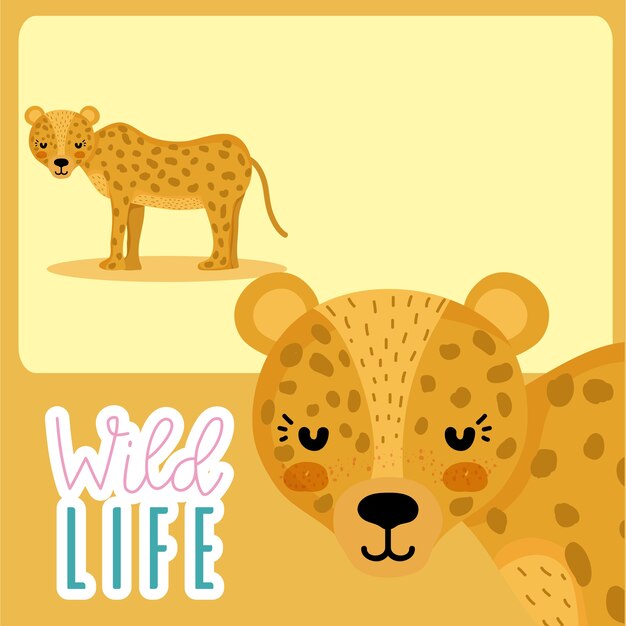Cheetah Fun Facts

Cheetahs are the fastest land animals on Earth, reaching speeds of up to 70 miles per hour!
Cheetahs have a unique body structure, with long legs and a flexible spine that allows them to achieve those incredible speeds.
Cheetahs have a distinctive coat pattern, with black spots on a golden background, acting as camouflage in their natural habitat.
Unlike other big cats, cheetahs cannot retract their claws fully, which gives them better traction for running.
Cheetahs have a specialized respiratory system and enlarged nostrils that allow them to take in more oxygen during a high-speed chase.
Cheetahs have a short burst of speed, as they can only maintain their top speed for a maximum of about 30 seconds.
Cheetahs have excellent eyesight, enabling them to spot prey from a distance and accurately judge their movements.
Cheetahs use their long, muscular tails for balance and steering while running at high speeds.
Despite their incredible speed, cheetahs have a low success rate when it comes to hunting, as their prey often escapes due to their short chase duration.
Cheetahs have a unique hunting strategy, relying on stalking and getting as close as possible to their prey before initiating a lightning-fast sprint.
Cheetahs have non-retractable claws, providing them with better grip when running, similar to cleats on running shoes.
Cheetahs are highly social animals, often living in small groups called coalitions, typically consisting of brothers from the same litter.
Cheetah Fun Facts part 2
Male cheetahs have a significantly shorter lifespan compared to females due to the challenges they face when defending territory and competing for mates.
Despite their speed, cheetahs have relatively weak jaws, making them unable to take down large prey. They often target smaller antelopes and gazelles.
Cheetahs have a unique purring sound, similar to domestic cats, which they use to communicate with each other.
Cheetahs have a gestation period of about 90-95 days before giving birth to a litter of up to six cubs.
Cheetah cubs have a distinctive mantle of greyish fur on their backs, providing camouflage before they develop their adult coat.
Cheetahs have a high mortality rate during the first few months of life, as they are vulnerable to predators such as lions and hyenas.
Cheetahs have a keen sense of hearing, which helps them detect any potential threats or approaching prey.
Cheetahs mark their territory using urine and claw markings on trees to warn other cheetahs to stay away.
Cheetahs have a slender body built for speed, with a lightweight frame and long legs to cover large distances quickly.
Cheetahs have a relatively small head compared to their body size, allowing for reduced air resistance while running.
Cheetahs are diurnal animals, meaning they are most active during the day and rely on their keen eyesight to hunt.
Contrary to popular belief, cheetahs cannot roar like other big cats. Instead, they vocalize through a variety of sounds including purring, hissing, and chirping.
Cheetahs have a specialized inner ear structure that helps maintain balance and stability while running at breakneck speeds.
Cheetahs have an average lifespan of about 10-12 years in the wild, but they can live up to 20 years in captivity.
Cheetahs have a unique hunting success rate of about 50%, which is relatively low compared to other predators.
Cheetahs have evolved to have large nasal passages and lungs, allowing for increased oxygen intake during their high-speed pursuits.
Cheetahs have specially adapted spinal disks that work as shock absorbers, minimizing the impact of their rapid acceleration and deceleration.
Cheetahs have a keen sense of sight, with their eyes positioned towards the front of their heads, providing better depth perception while hunting.
Cheetahs are excellent climbers and can maneuver easily on trees, often using elevated positions for better visibility.
Cheetahs rely on their extraordinary acceleration to catch their prey, reaching speeds of up to 30 miles per hour within a couple of seconds.
Cheetahs have partially retractable claws, giving them better traction for quick turns and pivots while chasing prey.
Cheetahs communicate with each other through a variety of vocalizations, visual signals, and body postures.
Cheetahs have black teardrop markings running from the inner corner of their eyes down to the sides of their mouth, helping to reduce glare from the sun.
Cheetahs have a lean physique and are not as muscular as other big cats, providing them with a lightweight advantage for explosive speed.
Cheetahs have a specialized hunting technique, often using tall grass and vegetation as cover before launching their high-speed chase.
Cheetahs have a keen sense of smell, enabling them to detect the presence of other animals, potential threats, or even a suitable mate.
Cheetahs have a flexible spine that acts as a spring, allowing them to extend their stride significantly and cover more ground while running.
Cheetahs have non-retractable claws to provide traction while running, similar to a sprinter’s cleats gripping the track.
Cheetahs have a slender, aerodynamic body shape, allowing for reduced air resistance and increased speed.
Cheetahs have incredibly fast reflexes, enabling them to change direction rapidly and make split-second decisions during a chase.
Cheetahs have a small head and a specialized inner ear structure, which helps minimize wind resistance while running at high speeds.
Cheetahs have a specialized digestive system, allowing them to eat quickly and avoid scavengers from stealing their kills.
Cheetahs have distinct facial markings, with black mascara-like streaks extending from the inner corner of their eyes, helping to reduce sun glare.

